Tumbling Blocks Blanket
Both playful and orderly, lively and subtle, we’ve fallen for our beautiful Tumbling Blocks Blanket in Morning!

A testimony to the wondrous potential of simple knits and purls, this blanket adds a few slipped stitches to the edges for a tidy I-cord border.
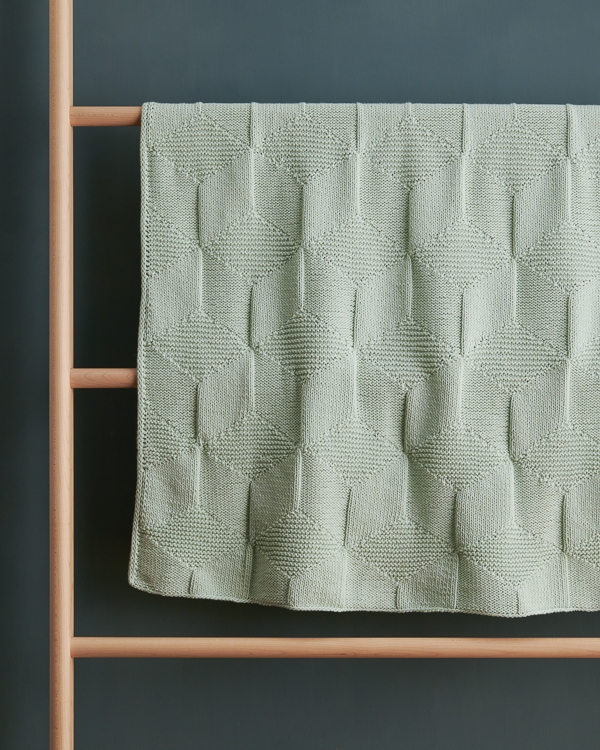
This blanket is an excellent choice for beginning knitters who are interested in learning to read and work with pattern repeats. Each row of stitches is easy to memorize, and small shifts between lines create a cascade of texture, satisfying (and motivating!) to watch as blocks fall into place on your needles.
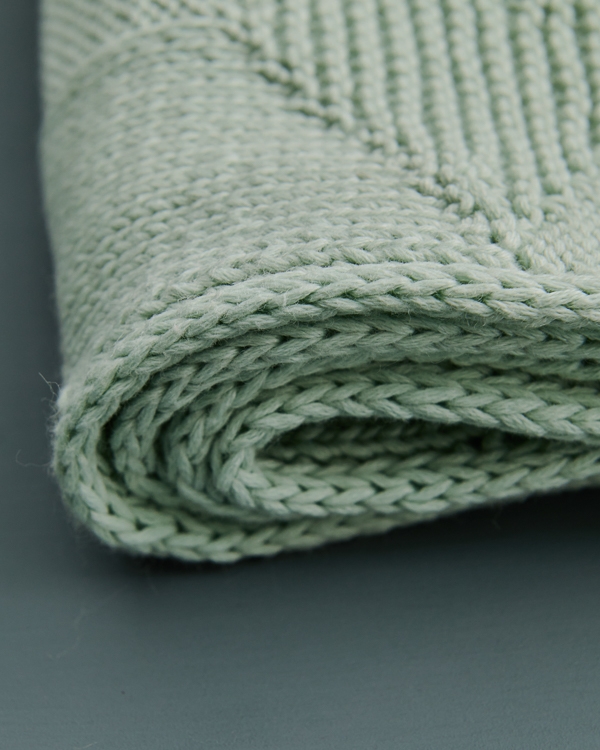
Morning, our very special blend of 75% organically grown cotton and 25% yak, has a satisfying weight that makes it a lovely choice for a blanket. Its eight plies and smooth spin create excellent stitch definition that keeps the cheerful tumbling blocks neat-as-a-pin.
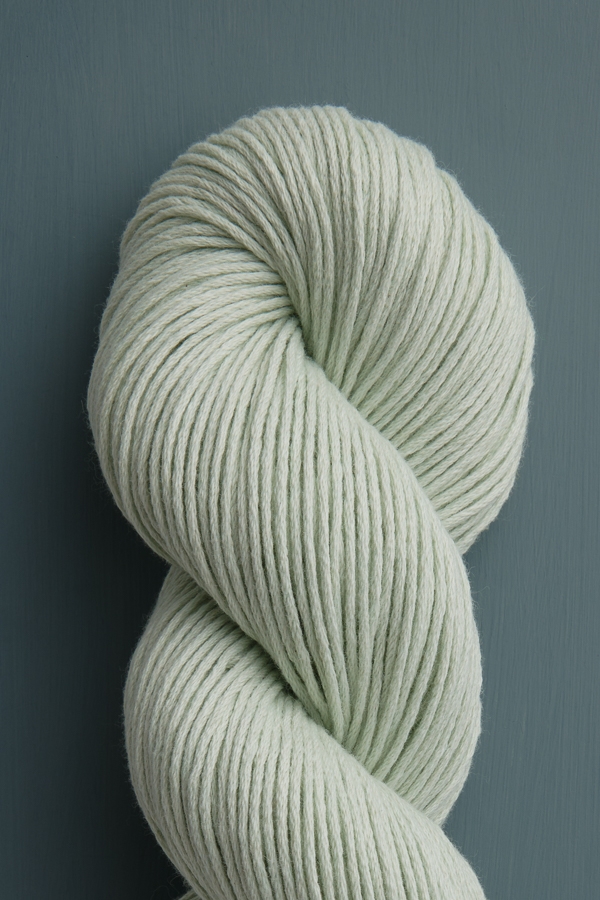
Add to this Morning’s soft feel and machine washability, and you have a winning combination! It takes just five skeins for a crib-size blanket and seven for a throw, so pick your favorite up-with-the-sun shade of Morning and cast on!

Designed by Purl Soho designer, Hiromi Glover. Click here to see even more of Hiromi’s work!
Share your progress and connect with the community by tagging your pics with #PurlSoho, #PurlSohoBusyHands, #PurlSohoTumblingBlocksBlanket, and #PurlSohoMorning. We can’t wait to see what you make!

Materials
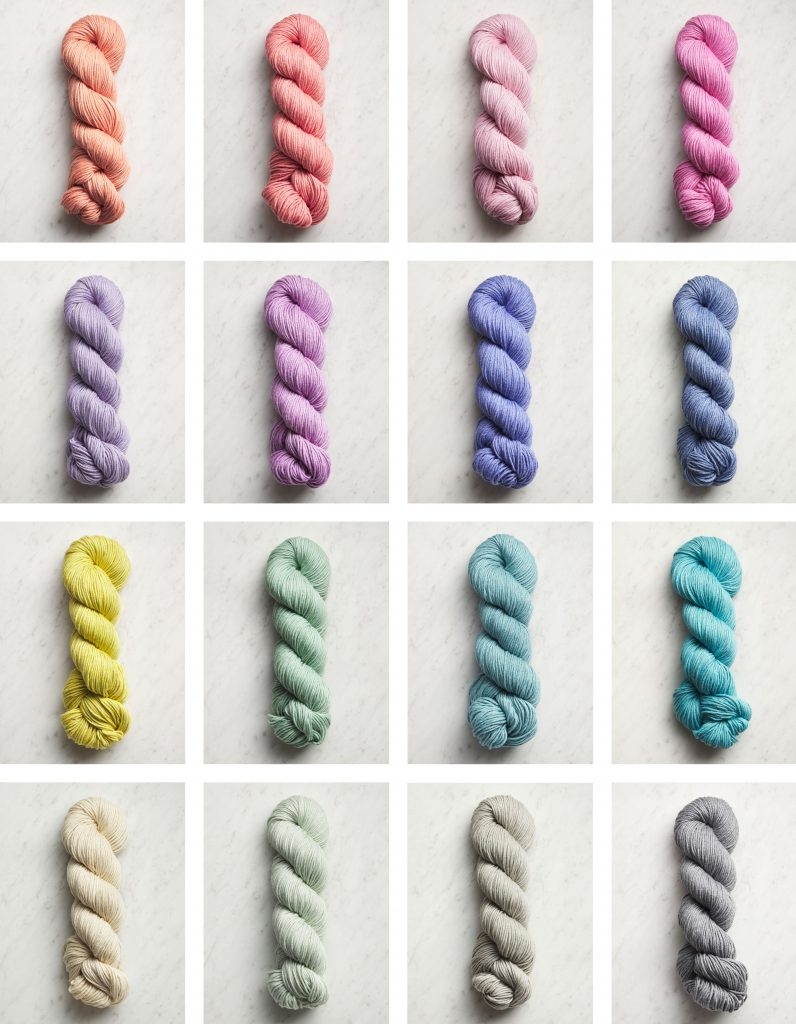
- 5 (7) skeins of Purl Soho’s Morning, 75% organically grown cotton and 25% yak. Each skein is approximately 191 yards/ 100 grams; approximately 860 (1337) total yards required. We used the color Cucumber Ice.
- US 6 (4 mm), 32-inch, or longer, circular needles
NOTE: For the Throw size, we used the entirety of our skeins, so if you want to be sure you have enough, consider ordering an extra skein. If you don’t end up needing it, you can return unwound yarn for a refund within 30 days of purchase, or within 6 months, for store credit. Our Return Policy has all the details!
GAUGE
19 stitches and 30 rows = 4 inches in stockinette stitch
SIZES
Crib (Throw)
Finished Dimensions: Approximately 32 inches wide x 32 inches long (32 inches wide x 52 inches long)
NOTE: You cast on the same number of stitches for both sizes, but for the Crib size, you work fewer repeats of the pattern and end up with a square!
SAMPLE: We knit the Throw size version for our sample.
NOTES
STITCH MULTIPLE
This pattern is worked over a multiple of 30 plus 8 stitches.
SLIP STITCHES
Slip all slipped stitches purlwise.
PATTERN
Cast on 158 stitches. We used a basic Long Tail Cast On.
Set-Up Row (wrong side): Slip 3 (see Notes) with yarn in front (wyif), k1, purl to last 4 stitches, k1, p3.
Now follow either the Written or Chart Instructions, both below.
TUMBLING BLOCKS PATTERN: WRITTEN INSTRUCTIONS
SECTION A
Row 1 (right side): Slip 3 with yarn in back (wyib), p1, [k15, p15] 5 times, p1, k3.
Row 2 (wrong side): Slip 3 wyif, k1, [k15, p15] 5 times, k1, p3.
Rows 3–10: Repeat Rows 1 and 2 four more times.
SECTION B
Row 1 (right side): Slip 3 wyib, p1, [k14, p1, k1, p14] 5 times, p1, k3.
Row 2 (wrong side): Slip 3 wyif, k1, [k13, p1, k3, p13] 5 times, k1, p3.
Row 3: Slip 3 wyib, p1, [k12, p1, k5, p12] 5 times, p1, k3.
Row 4: Slip 3 wyif, k1, [k11, p1, k7, p11] 5 times, k1, p3.
Row 5: Slip 3 wyib, p1, [k10, p1, k9, p10] 5 times, p1, k3.
Row 6: Slip 3 wyif, k1, [k9, p1, k11, p9] 5 times, k1, p3.
Row 7: Slip 3 wyib, p1, [k8, p1, k13, p8] 5 times, p1, k3.
Row 8: Slip 3 wyif, k1, [k7, p1, k15, p7] 5 times, k1, p3.
Row 9: Slip 3 wyib, p1, [k6, p1, k17, p6] 5 times, p1, k3.
Row 10: Slip 3 wyif, k1, [k5, p1, k19, p5] 5 times, k1, p3.
Row 11: Slip 3 wyib, p1, [k4, p1, k21, p4] 5 times, p1, k3.
Row 12: Slip 3 wyif, k1, [k3, p1, k23, p3] 5 times, k1, p3.
Row 13: Slip 3 wyib, p1, [k2, p1, k25, p2] 5 times, p1, k3.
Row 14: Slip 3 wyif, k1, [k1, p1, k27, p1] 5 times, k1, p3.
Row 15: Slip 3 wyib, p1, [p1, k27, p1, k1] 5 times, p1, k3.
Row 16: Slip 3 wyif, k1, [p2, k25, p1, k2] 5 times, k1, p3.
Row 17: Slip 3 wyib, p1, [p3, k23, p1, k3] 5 times, p1, k3.
Row 18: Slip 3 wyif, k1, [p4, k21, p1, k4] 5 times, k1, p3.
Row 19: Slip 3 wyib, p1, [p5, k19, p1, k5] 5 times, p1, k3.
Row 20: Slip 3 wyif, k1, [p6, k17, p1, k6] 5 times, k1, p3.
Row 21: Slip 3 wyib, p1, [p7, k15, p1, k7] 5 times, p1, k3.
Row 22: Slip 3 wyif, k1, [p8, k13, p1, k8] 5 times, k1, p3.
Row 23: Slip 3 wyib, p1, [p9, k11, p1, k9] 5 times, p1, k3.
Row 24: Slip 3 wyif, k1, [p10, k9, p1, k10] 5 times, k1, p3.
Row 25: Slip 3 wyib, p1, [p11, k7, p1, k11] 5 times, p1, k3.
Row 26: Slip 3 wyif, k1, [p12, k5, p1, k12] 5 times, k1, p3.
Row 27: Slip 3 wyib, p1, [p13, k3, p1, k13] 5 times, p1, k3.
Row 28: Slip 3 wyif, k1, [p14, k1, p1, k14] 5 times, k1, p3.
SECTION C
Row 1(right side): Slip 3 wyib, p1, [p15, k15] 5 times, p1, k3.
Row 2 (wrong side): Slip 3 wyif, k1, [p15, k15] 5 times, k1, p3.
Repeat last two rows 4 more times.
SECTION D
Row 1 (right side): Slip 3 wyib, p1, [k1, p14, k14, p1] 5 times, p1, k3.
Row 2 (wrong side): Slip 3 wyif, k1, [k2, p13, k13, p1, k1] 5 times, k1, p3.
Row 3: Slip 3 wyib, p1, [k3, p12, k12, p1, k2] 5 times, p1, k3.
Row 4: Slip 3 wyif, k1, [k4, p11, k11, p1, k3] 5 times, k1, p3.
Row 5: Slip 3 wyib, p1, [k5, p10, k10, p1, k4] 5 times, p1, k3.
Row 6: Slip 3 wyif, k1, [k6, p9, k9, p1, k5] 5 times, k1, p3.
Row 7: Slip 3 wyib, p1, [k7, p8, k8, p1, k6] 5 times, p1, k3.
Row 8: Slip 3 wyif, k1, [k8, p7, k7, p1, k7] 5 times, k1, p3.
Row 9: Slip 3 wyib, p1, [k9, p6, k6, p1, k8] 5 times, p1, k3.
Row 10: Slip 3 wyif, k1, [k10, p5, k5, p1, k9] 5 times, k1, p3.
Row 11: Slip 3 wyib, p1, [k11, p4, k4, p1, k10] 5 times, p1, k3.
Row 12: Slip 3 wyif, k1, [k12, p3, k3, p1, k11] 5 times, k1, p3.
Row 13: Slip 3 wyib, p1, [k13, p2, k2, p1, k12] 5 times, p1, k3.
Row 14: Slip 3 wyif, k1, [k14, p1, k1, p1, k13] 5 times, k1, p3.
Row 15: Slip 3 wyib, p1, [k13, p1, k1, p1, k14] 5 times, p1, k3.
Row 16: Slip 3 wyif, k1, [k12, p1, k2, p2, k13] 5 times, k1, p3.
Row 17: Slip 3 wyib, p1, [k11, p1, k3, p3, k12] 5 times, p1, k3.
Row 18: Slip 3 wyif, k1, [k10, p1, k4, p4, k11] 5 times, k1, p3.
Row 19: Slip 3 wyib, p1, [k9, p1, k5, p5, k10] 5 times, p1, k3.
Row 20: Slip 3 wyif, k1, [k8, p1, k6, p6, k9] 5 times, k1, p3.
Row 21: Slip 3 wyib, p1, [k7, p1, k7, p7, k8] 5 times, p1, k3.
Row 22: Slip 3 wyif, k1, [k6, p1, k8, p8, k7] 5 times, k1, p3.
Row 23: Slip 3 wyib, p1, [k5, p1, k9, p9, k6] 5 times, p1, k3.
Row 24: Slip 3 wyif, k1, [k4, p1, k10, p10, k5] 5 times, k1, p3.
Row 25: Slip 3 wyib, p1, [k3, p1, k11, p11, k4] 5 times, p1, k3.
Row 26: Slip 3 wyif, k1, [k2, p1, k12, p12, k3] 5 times, k1, p3.
Row 27: Slip 3 wyib, p1, [k1, p1, k13, p13, k2] 5 times, p1, k3.
Row 28: Slip 3 wyif, k1, [p1, k14, p14, k1] 5 times, k1, p3.
CONTINUE
Repeat Sections A–D 2 (4) more times, then repeat Section A one more time.
Go on to Finishing, below.
TUMBLING BLOCKS PATTERN: CHART
NOTE: New to reading charts? Unravel the mysteries with our Reading a Chart Tutorial.
Starting at the bottom right corner of the Chart below, work right-side (odd number) rows from right to left and wrong-side (even number) rows from left to right.
Work Sections A–D 3 (5) times, then repeat Section A one more time, then go on to the Finishing section, below.
KEY
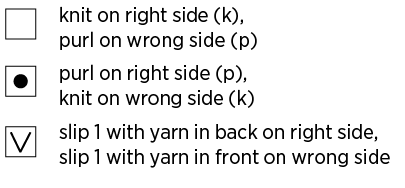
CHART
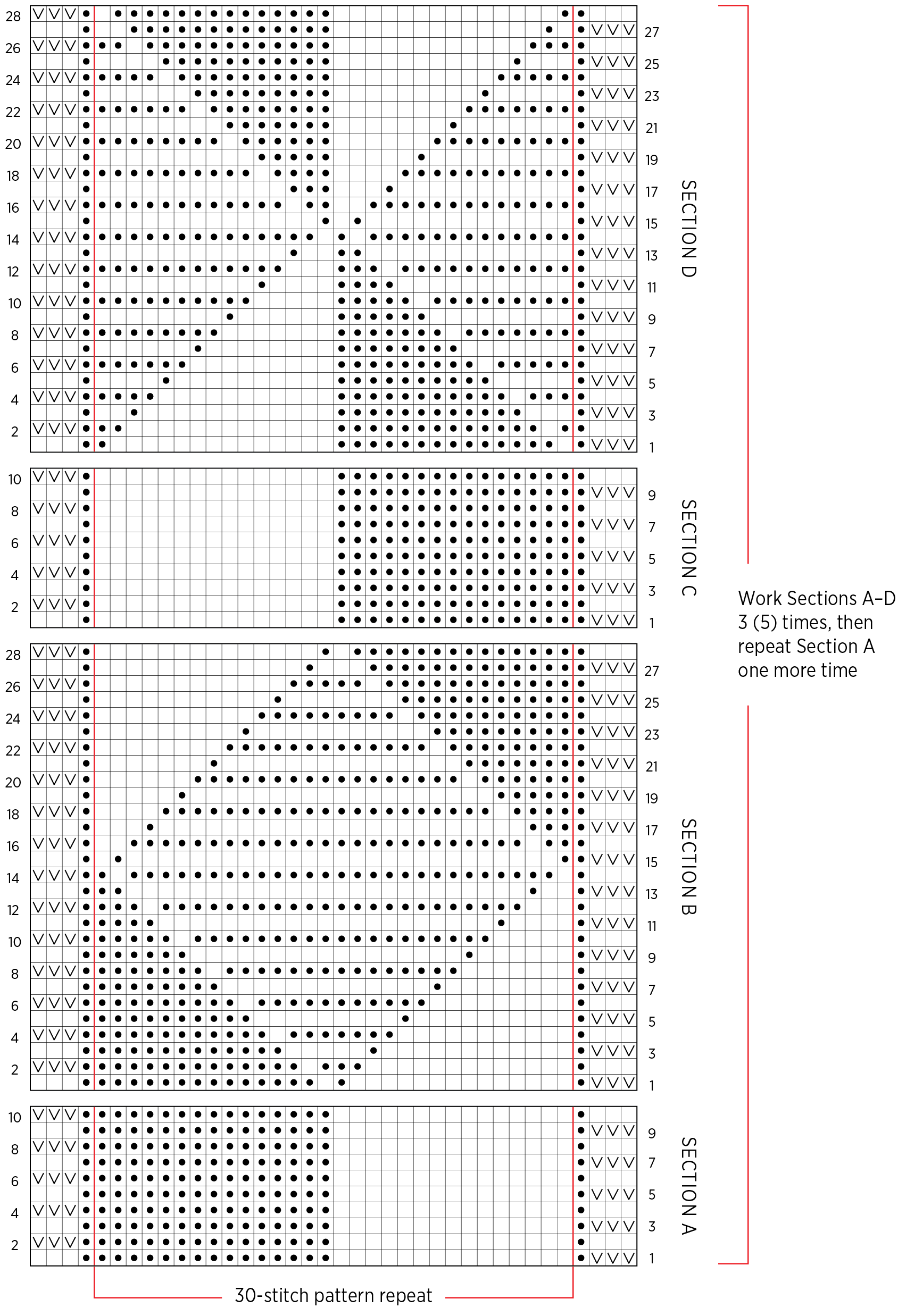
NOTE: Want to see it bigger? Download this chart (and key) as a PDF!
FINISHING
Next Row (right side): Slip 3 wyib, p1, [k15, p15] 5 times, p1, k3.
Next Row (wrong side): Slip 3 wyif, k1, purl to last 4 stitches, k1, p3.
With right-side facing, bind off knitwise.
Weave in the ends and gently wet block.
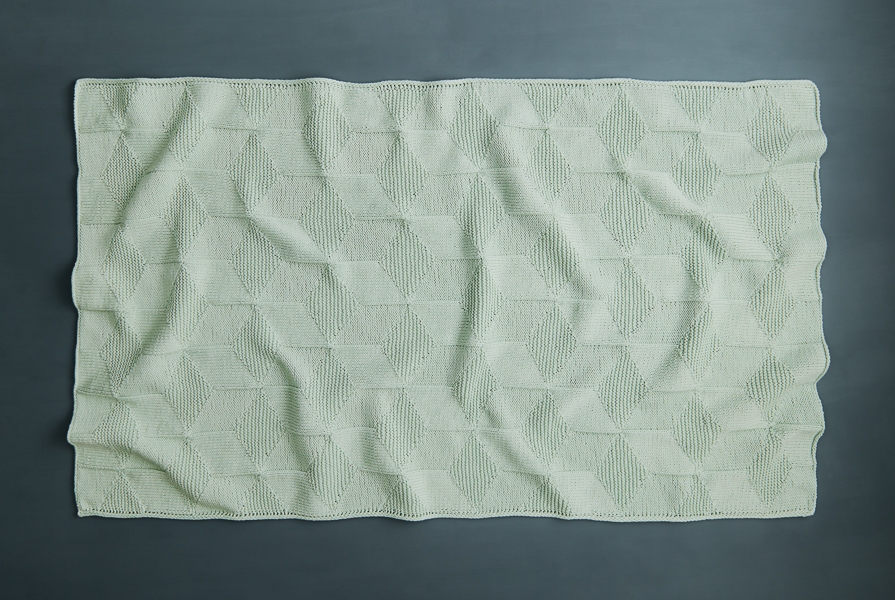



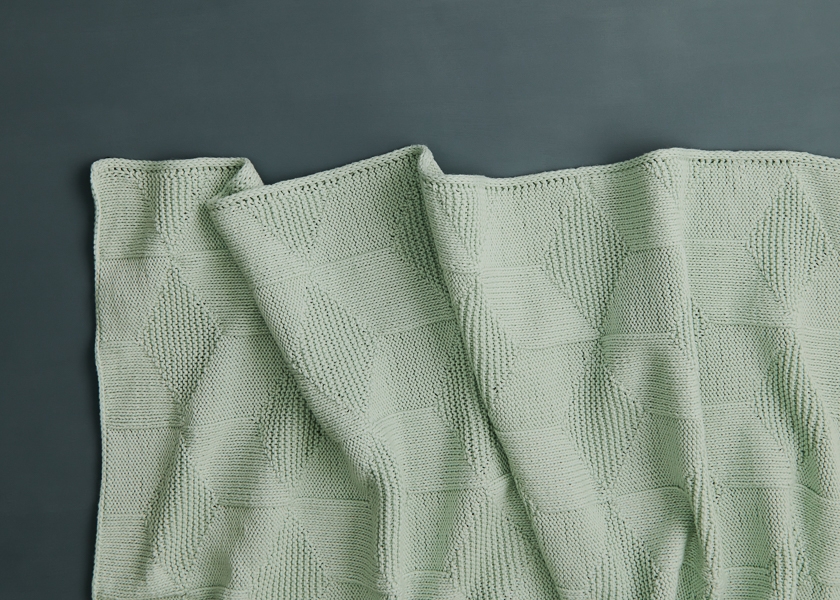
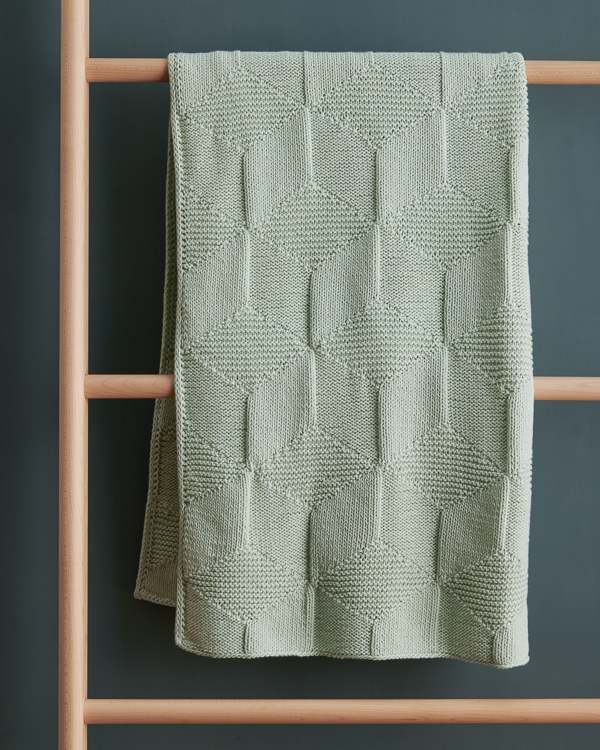
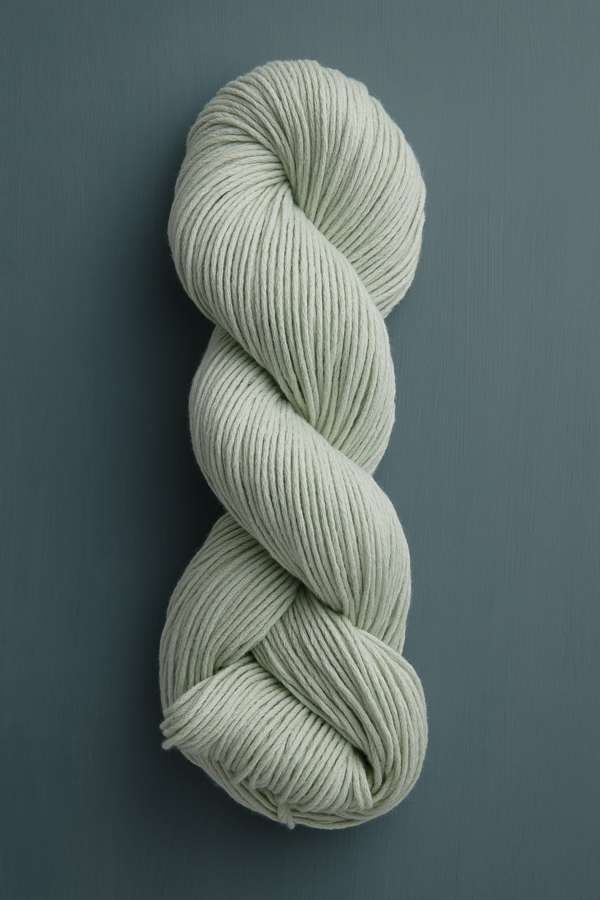

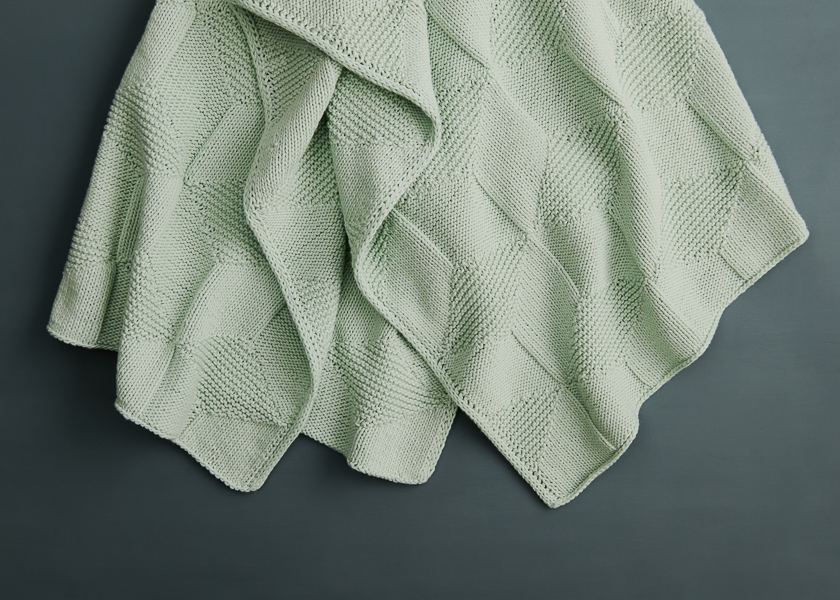


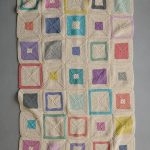
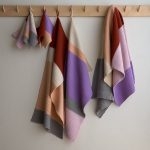
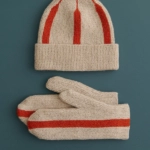
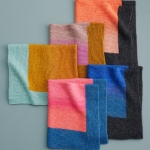

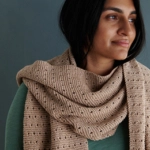
This is such a lovely blanket. Thanks so much for sharing this pattern, which I can’t wait to start making. May I know what are the qdditional stiches I should add on if I want to make a bigger blancket, meaning in multiples of how many stitches. Many thanks!
Hi Irene,
We’re so glad to hear that this pattern has caught your eye! The stitch multiple is 30 + 8. Hope this helps you adjust your blanket!
All the best,
Lili
How can I print just the pattern without all the extras?
Hi Raynetta,
Thanks for reaching out! Here’s how you can create a printer-friendly version of this page: If you’re on your computer, you’ll find a “print” icon in the right column just below the “Save To Favorites” button. If you’re on a mobile version of the site, you will find the “print” icon below the pattern and above the comments.
Click on this button, and a window will pop up where you can delete whichever parts of the pattern you don’t want to print. When you hover over any image or a text block, it will be highlighted in yellow and a “trash” icon will appear. Just click on this icon to delete anything that’s not necessary to the pattern! For example, you may decide to shorten the pattern by omitting certain images or the list of materials. Then, just click on the “Print” button in the upper left-hand corner of the pop-up window!
All the best,
Lili
Thank you!
Just found your website. I really like it and the patterns and the yarn looks fabulous. First of all, I cannot find any place on this page that states the cost of the yarn. How much is it? Also, I don’t quite understand the discount ‘process’. Please explain.
Thank you,
Hi June,
Thanks for reaching out, and we’re glad to hear that you like our website! The price of each product is included on the product page. For example, you can find the product page for Morning at this link. Morning is currently on sale, so you will get the discounted price automatically when you add the skeins to your cart!
If you’d like to receive the new customer discount, then you’ll need to sign up for our newsletter, which you can do by clicking on NEWSLETTER in the upper-right-hand corner of the website and entering your email address. You will then receive a welcome email that includes a discount code. This code can be entered into the Customer Code field on the checkout page to apply the discount! Just a heads up though, it’s only applicable to regularly-priced Purl Soho-brand items, so it will not apply to anything that is currently on sale.
I hope this helps clarify things!
All the best,
Lili
What a lovely blanket! I have a cone of Cotton Pure. How many stitches to cast on for a crib blanket in Cotton Pure?
Thank you!
Hi Miriam,
I would recommend first making a gauge swatch in pattern with Cotton Pure! Once you know how many stitches you are getting per inch, you can multiply that number by the width that you would like and cast on the nearest multiple of 30 + 8. Then you can follow the pattern as written!
All the best,
Lili
This Tumbling Blocks Blanket looks so fun to make! I bought 7 skeins of Santolina to make a different blanket. Can I use them on this one? Holding 2 strands together? Do I have enough skeins? What is the “weight” of Santolina compared to Morning? (sport, fingering, worsted?)
Hi Jane,
Those are great questions! Santolina is a fingering weight yarn, so it’s much thinner than Morning. Holding two strands together would make it much more similar to the weight of Morning, but you would not have enough yardage to complete the throw size (you’d need double, and 7 skeins of Santolina isn’t quite double 1337 yards).
The best option to use the Santolina you have for this project would actually be to knit with it held single! The only modification you’d need to do in that case would be to change the cast-on number so that the blanket still comes to the correct dimensions, even with a thinner yarn.
To figure out your cast-on number, you will want to first knit a gauge swatch in pattern. Once you know how many stitches you are getting per inch, you can multiply that number by the width that you would like and cast on the nearest multiple of 30 + 8. Then you can follow the pattern as written until the blanket is as long as you’d like!
I hope this helps, and please let me know if you have any other questions.
All the best,
Lili
This blanket looks lovely, and I’m excited to make it for a couple of new babies in my life. But I can’t get more than a few rows without taking it out, in frustration at the I-cord edge. It’s not shaping up like any I-cord edge I’ve done. The instructions are also different from what I’ve seen in the past, and I can’t figure out what I might be doing wrong. I might try to modify according to other I-cord edges I’ve done.
Hi Heather,
We’re sorry to hear that you’re having trouble with the i-cord edge in this project! Would you be able to send a photo of your blanket so far to customerservice@purlsoho.com? That way, we’ll be able to better visualize what’s going on and give advice on how you might proceed!
All the best,
Lili
Thanks, Lili, I’m ok now. I’m using a method I already know, slipping wyif at the end of every row and starting each row with a k3.
You’re very welcome! That’s a very good solution, and it will create an i-cord that looks just like the one in our sample!
All the best,
Lili
Could you suggest another yarn that would be similar?
Thanks
Pat
Hi Pat,
Thanks for reaching out! Since this blanket was designed for a DK weight yarn, many other DK weight yarns would be a great choice. You can browse through our other DK options right here, and in particular, I’d recommend Knitting Yarn. This yarn is 100% merino wool, so it’s super soft, and it has great stitch definition, which will make the design pop!
All the best,
Lili
Lovely pattern. I had the same problem as Heather. Specifically, the slip 3 with yarn in back followed by a purl leaves an unsightly loop. Should it be slip 3 with yarn in front? I will try Heather’s solution instead.
Hi Lisa,
Thanks for writing in! I can confirm that the pattern is correct as written–it’s a slip 3 wyib for the right side rows, so that the float ends up on the wrong side of the blanket. I recommend knitting a little further, and you’ll probably find that the tension in the i-cords will even out eventually. But you can absolutely try Heather’s solution instead! There are many correct ways to knit an i-cord border, and some might work better for you than others. Let us know how it goes if you try this!
All the best,
Lili
Thank you, Lili! I will stick with the pattern and am confident it will work out.
I have completed sections A-D 4 times total on my project, and I already feel it’s big enough for my purposes. Can I move on to doing section A one more time and then finishing without doing another round of A-D, or will that mess with the pattern?
Hi Kat,
Thanks for writing in! Yes, you can absolutely move onto the final Section A at any point after finishing a Section D. Hope this helps, and have fun finishing up your blanket!
All the best,
Lili
Is there a correction in the tumbling blocks pattern?
Appears the pattern isn’t developing right.
Hi Anne,
I’m sorry to hear that your project isn’t turning out as expected! We haven’t caught any errors yet, but we’re happy to take a closer look. Can you please let me know what part of the pattern is causing the difficulties? It would also be incredibly helpful if you can send a photo of your work to customerservice@purlsoho.com. That way, we can better visualize what’s going on and provide advice from there!
All the best,
Lili
I think this blanket is adorable! But I’m 4 rows into Section A and I’m questioning if I want to continue because of the curling at the edge. I don’t want to put all the time and not like the look. Even if I can flatten it a bit during blocking (not my super strength), won’t it continue to curl after it’s washed/dried by my friend? I was drawn to this yarn because it can be washed (new mom). How are others feeling? I’ve seen some photos … most have curling…it doesn’t look terrible to me, but I’m just not sure. I’m so on the fence about ripping it out and doing something different.
Hi Nicole,
I’m sorry to hear that you’re experiencing so much curling! Since this blanket contains both knit and purl sections, once you knit more (and especially after blocking), the curling should be minimized. If you’re still feeling like the curling you’re experiencing is more than normal, would you be able to send a photo of your work to customerservice@purlsoho.com? That way, we can better visualize what’s going on!
All the best,
Lili
Hello, I want to use Heather’s method for edges.
Do I slip 3 wyif at the end of each row ?
Thank you,
AJ
Hi Anita,
Thanks for reaching out! I believe the method Heather used was to slip the last 3 stitches with yarn in front and then knit those same stitches (the first 3) on the next row. I hope this helps.
Happy knitting,
Gavriella
I actually took earlier advice from Lili and knitted a few more rows and got the original pattern to look great !
Thank you
Hi Gavriella,
I decided to take the advice I had seen earlier from Lili and continue knitting a few rows. It looks beautiful just as pattern is written !
Thank you
Anita
I bought seven skeins of Morning but now I decided I should cast on an additional 30 stitches. Will this be enough for a full size throw? Thanks
Hi Mary,
Thank you for your question! To get a full-size throw of 32 inches wide x 52 inches long, you will need to cast on 158 stitches and work Sections A–D five times. If you aren’t sure if you are on track to getting the right size, I would suggest knitting a gauge swatch to ensure you have enough yarn for the pattern. You can check out our gauge tutorial here for further instructions on adjusting your needle sizes as needed. I always find it to be a helpful reference when adjusting my needle sizes. I hope this helps!
All the best,
Gavriella
Just finished this and it turned out so nice. I used Blue Sky Organic Cotton, so it came out a little larger than the dimensions mentioned. I used stitch markers to keep me straight on each of the repeats. They were a lifesaver for me, and helped me avoid mistakes, or at least notice them much faster. Thanks for designing such a great pattern.
Hi,
I’m loving this pattern and it’s coming out nicely so far.
Can you clarify section C please? Am I repeating those two rows 4 times “row 1 and 2?”
Hi Jodi,
Yes, that’s correct! You repeat the two rows in this section 4 more times after you work through them the first time. So you actually repeat them a total of 5 times (10 rows total)!
All the best,
Lili
My niece is having baby in fall; I need pink. Have been planning to make this baby blanket since I heard the news. Just talked to niece today and yes she wants pink! Do you know when the beuatiful pink will be back in stock? Anxiously awaiting
Sincerely Patty
Hi Patty,
Thanks for reaching out! We’re hoping to have Morning in Pink Radish back in stock around early June. We’re so sorry for the delay and are anxious to see it back too!
If that’s not too late for you, we’d recommend signing up to be notified when it returns by going to the product page, selecting Pink Radish, and entering your email address. You can repeat this step for each color you’re interested in. This way, you’ll be among the first to know when it’s available on the website again!
Please let us know if you have any other questions.
All the best,
Gavriella
Oh it is great to know it will be back in time to knit up this cute pattern in time for delivery
thanks Gavriella!!
yes Im on list to be notified, and it anyone returns 6 skeins befor then please call me!!!
You are very welcome Patty!
I’m wondering if campo in quiet blue or renaissance blue would have enough stitch definition would work for this pattern. Thank you
Hi Mary,
Thank you for writing in! Campo does have wonderful stitch definition making it a great choice for textured patterns. Although you could definitely use it for this pattern, you will need to adjust your cast on number since the Campo is a bit thicker than Morning. This pattern is worked over a multiple of 30 plus 8 stitches so after making a gauge swatch you could adjust your stitch count accordingly depending on your desired dimensions for your blanket. I hope this helps!
Happy making,
Gavriella